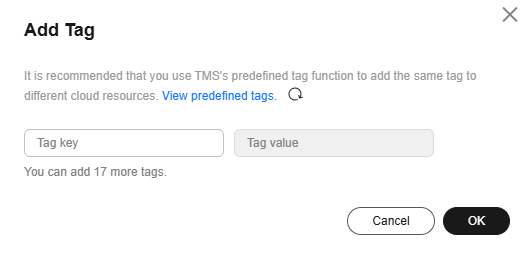Adding a Tag to a Secret
Tags are used to identify secrets. You can easily classify and track secrets using tags.
Prerequisites
Procedure
- Log in to the DEW console.
- Click
 in the upper left corner and select a region or project.
in the upper left corner and select a region or project. - In the navigation pane on the left, choose .
- Click a secret name to access its details page.
- In the Tags area, click Add Tag, as shown in Figure 1. In the Add Tag dialog box, enter the tag key and tag value. Table 1 describes the parameters.

- If you want to use the same tag to identify multiple cloud resources, you can create predefined tags in the TMS. In this way, the same tag can be selected for all services. For more information about predefined tags, see the Tag Management Service User Guide.
- To delete a tag, click Delete next to it.
Table 1 Tag parameters Parameter
Description
Remarks
Tag key
Tag name.
The tag keys of a secret cannot have duplicate values. A tag key can be used for multiple secrets.
A secret can have up to 20 tags.
- Mandatory.
- The tag key must be unique for the same custom key.
- 128 characters limit.
- The value cannot start or end with a space.
- Cannot start with _sys_.
- The following character types are allowed:
- Chinese
- English
- Numbers
- Space
- Special characters: _.:/=+-@
Tag value
Value of the tag
- Optional
- 255 characters limit.
- The following character types are allowed:
- Chinese
- English
- Numbers
- Space
- Special characters: _.:/=+-@
- Click OK.
Related Operations
- Modifying a tag value:
- Click a secret name to access its details page.
- In the Tags area, locate the target tag and click Edit in the Operation column.
- In the Edit Tag dialog box, enter a tag value and click OK.
- Deleting a tag:
- Click a secret name to access its details page.
- In the Tags area, locate the target tag and click Delete in the Operation column.
- In the Delete Tag dialog box, click Yes.
Feedback
Was this page helpful?
Provide feedbackThank you very much for your feedback. We will continue working to improve the documentation.







